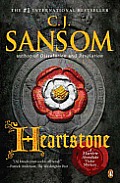 I came by this tasty book by reading an interview Lesley Ann Sharrock, who wrote a novel I much admire called The Seventh Magpie. Would that I had known of it earlier. I think I would have enjoyed it even more if I had not recently indulged in Hilary Mantel’s Bringing up the Bodies and Wolf Hall, both also set in Henry VIII’s England. These two rank among the very best historical novels I’ve ever read, and though they are different works with different purposes than Samson’s, they begged comparison with Hilary on every page. Still, Heartstone holds up quite well, and the comparison is in some ways unfair, since it is set almost entirely outside Henry’s court instead of deep in the heart of it.
I came by this tasty book by reading an interview Lesley Ann Sharrock, who wrote a novel I much admire called The Seventh Magpie. Would that I had known of it earlier. I think I would have enjoyed it even more if I had not recently indulged in Hilary Mantel’s Bringing up the Bodies and Wolf Hall, both also set in Henry VIII’s England. These two rank among the very best historical novels I’ve ever read, and though they are different works with different purposes than Samson’s, they begged comparison with Hilary on every page. Still, Heartstone holds up quite well, and the comparison is in some ways unfair, since it is set almost entirely outside Henry’s court instead of deep in the heart of it.

C.J. Samson‘s protagonist is one Matthew Shardlake, an often-despised humpback lawyer whose deformity often gives him the advantage of often being taken lightly by his antagonists. Those who underestimate him do so at their peril. The plot here is intricate and multifold. Shardlake is hired by a woman close to the Queen (Catherine Parr is current on H’s list of wives at this point in history, 1545) to investigate the possible mistreatment of a couple of children who are wards of a prominent family. Simultaneously, he feels compelled to investigate the history of a woman who’s been many years confined to Bedlam but whom he’s come to suspect is there unjustly.
Besides his deformity and his resultant curious place in society, Shardlake is an interesting protagonist for other reasons. He is not the brightest torch in the parade. He misreads clues, offends people needlessly, accuses suspects sans proof. Is such a one an investigator (he’s not officially a detective, though would be so named if he were of a later period.) worthy of the name? Yes, indeed, for the quality he possesses above all others is persistence. Even when he’s discouraged and regretful about his missteps, he never relents in his quest for truth. He steps on royal toes, noble toes, even military toes as he follows his clues even into the thick of a booming naval battle with the French. His rewards in the end are neither fully satisfying nor universally enduring. However, he gets what he goes after, even if the putative benefactors of his efforts are sometimes ungrateful or even hostile.
Sansom surrounds his story with remarkably complete detail, both in terms of the characters and physical elements of the environment. We know much about the different kinds of trees around Portsmouth before we’re done. We come away with intricate descriptions of all the tools and procedures of Tudor-era naval warfare, spend time above and below decks with sailors, soldiers, and officers. Spicing it all is as entertaining a collection of names as I ever encountered. Bealknap, Fettiplace, Alabaster, Mylling, Hobbey, Quintin Priddis, and a host of others.
I will say that at times the detail encumbers the narrative to the point where I found myself skipping descriptions to get on with the story, but it’s a rich tapestry that rewards careful examination. Not only that, but the mysteries and their solutions offer as much intrigue and as many twists as the best detective story–and there’s no DNA or other technology to help poor Shardlake on his road to explanations. But he gets there anyhow, and Sansom makes his journey entertaining every halting step.
